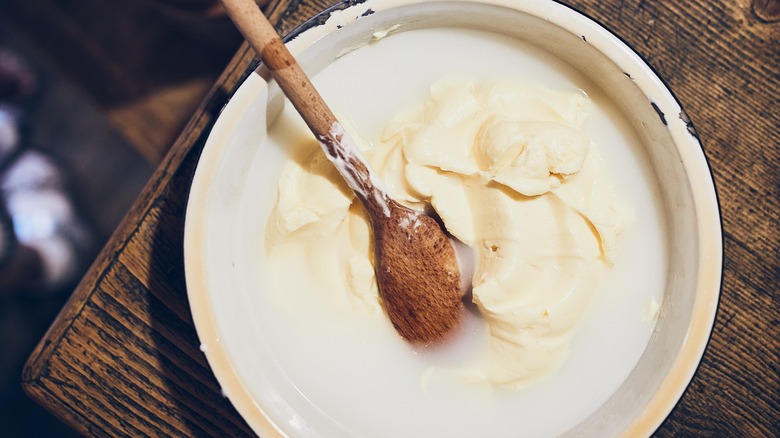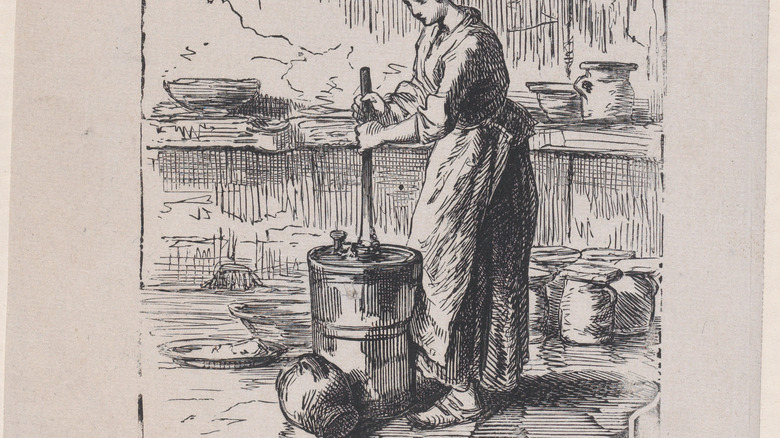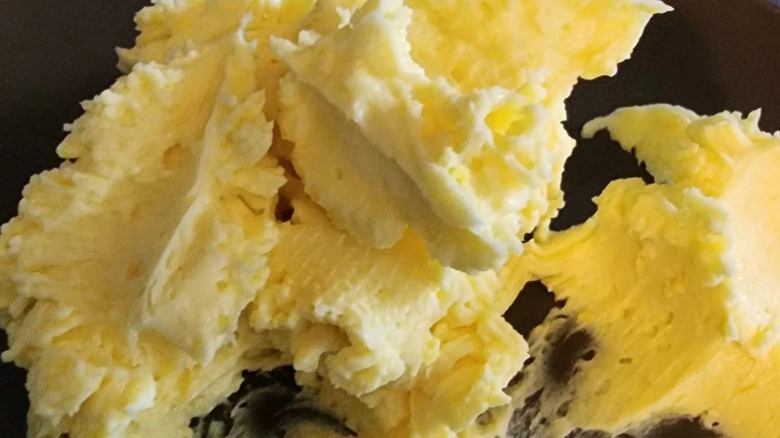Fairy Butter Is An Easy Colonial-Era Spread You Can Make Today
Though we might think of compound butter as a more modern invention, cooks have been flavoring butter as far back as the 18th century. Back then, however, the was no butter quite as magical as fairy butter. Not to be confused with fairy bread, fairy butter is a sweet, spreadable confection that absolutely oozes flavor and history. Fairy butter is a Colonial-era recipe that deserves a place at your table.
Fairy butter is a mixture of four key ingredients: butter, sugar, hard-boiled egg yolks, and flower water. For those not familiar with the final ingredient, flower water is an infusion of water and flower petals. During the Colonial era, it was prized more for its aroma than for its flavor. Today, flower water is primarily used as an all-natural air freshener, but can also be used to add floral qualities to foods. Rose and orange blossom water are the most common and were historically interchangeable in the making of fairy butter.
As with almost everything in history, there is more to fairy butter than meets the eye. Though today we tend to dismiss the power of myth and folklore, the origins of fairy butter, particularly its name, can be found in these mystical annals. And while it may not be the most appetizing of origins, it nevertheless makes for fascinating history.
The folklore of fairy butter
Far from being a food myth, the origins of fairy butter are rooted in the folklore of England, Ireland, Wales, Scandinavia, and the United States, which is riddled with fairies, witches, and trolls. Many precautions were taken by farmers and townsfolk to ward off spirits and creatures and keep them away from one of their most prized possessions: butter. Long before refrigeration and industrialization, butter was hand-churned at home at set points throughout the year. Its storage, therefore, was highly crucial. To protect it, certain rituals such as splashes of Holy Water were used.
The culinary fairy butter is actually said to have gotten its name from a number of different fungi. The jelly fungi, or tree mushrooms, Tremella aurantia and Tremella mesenterica have bright yellow-orange colors and thick textures reminiscent of butter. As their scientific properties were not yet known in the 18th century, lore cropped up about how the fungi were placed in the forest by fairies attempting to hide butter they'd stolen.
The slime mold known as Fuligo septica is also said to have been a source of inspiration for fairy butter. This ground mold has a stringy, mossy consistency, and creeps up in fields after a good rain. Rituals on Midsummer's Eve often involved the burning of both types of fungus, as it was believed to ward off the thieving spirits.
Historic recipes
Regardless of the folklore that inspired it, solid historical evidence for fairy butter exists in several period cookbooks from England, Scotland, and the United States. Though it is not exactly known when the recipe for fairy butter was first created, it nevertheless grew in popularity from its inception onwards. It is said to have been a favorite treat of First Lady Dolley Madison, wife of President James Madison.
Making fairy butter was, and remains, incredibly simple. You take egg yolks, softened butter, sugar, and a few spoonfuls of your chosen flower water, and mix them all together until smooth. Obviously, measurements depend on how much fairy butter you intend to make, as well as how much floral flavor you want. Flower water can be quite strong, and can therefore take some getting used to.
If you want to give your butter the stringy effect of the lichen fungus it's named after, simply push the fairy butter through a strainer or sieve. The butter will turn stringy and come out looking remarkably forest-like. Historically, fairy butter has been paired alongside crackers, sweet breads, scones, and gingerbread. It also serves as an excellent accompaniment to pancakes and would make a great addition to a fancy afternoon tea. The choice is up to you on how to use it once it's made. Just make sure you bless any leftovers to ward off any thieving spirits.


